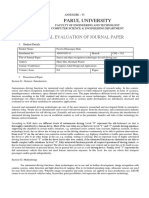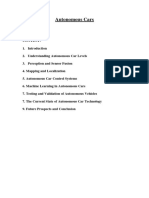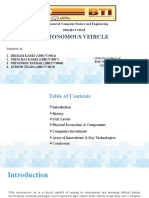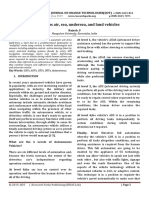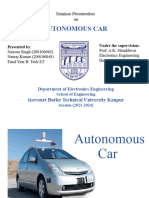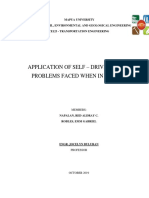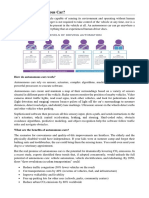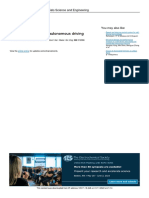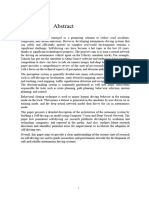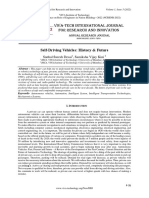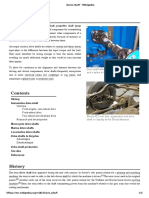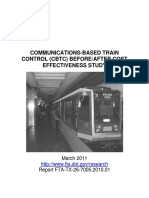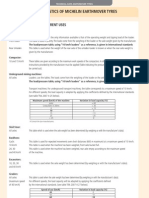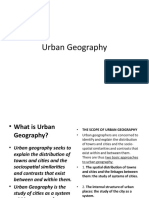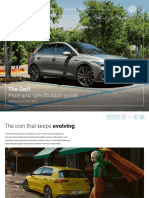Arab Academy for Science and Technology
College of Language and Communication
ESP III (English for Engineering)
Technical Report Writing
Autonomous Vehicles
(Fall, 2020)
Submitted by: ……………….
Department: Electrical & Control Engineering
Reg #: 19100377
Submitted to: …………………..
Submitted on: January 11, 2021
1
� Acknowledgments
I have learnt a great deal from those who have worked with me over the semester and
gratefully acknowledge my debt to them, especially Miss……………... My teachers who so
quickly found the weak points in my materials, have contributed in a fundamental way to my
understanding of how reports are written. I would also like to appreciate and express my thanks to
them for their enthusiastic and expert guidance. I could not have accomplished this work without
them whose experience guided me through the various stages of the report. To my teachers, I am
truly grateful.
2
� Abstract
The purpose of this report is to inform the reader on what are autonomous vehicles and
what are they used for. The report starts by introducing what are the levels of autonomous
driving and what happens in each level. Further, it states the components used in autonomous
vehicles, such as: cameras, radars, LIDAR andultrasonic, and how each component works. Then,
it moves to explaining some of the communication technologies implemented in such an
invention, and some of the applications where autonomous vehicles are used including
transportation and shipping industry. Towards the end, the report concludes by highlighting how
important the applications of autonomous vehiclesare, and how it could represent the next leap of
technology over the next decades in the fields of transportation and shipping industry as well.
3
� Table of Contents
pages
1. Introduction ………………………………………………………………………… 5
1.1. Definition ………………………………………………………………………… 5
1.2. Historical Background……………………………………………………………… 5
1.3. Significance of the topic…………………………………………………………… 5
1.4. Scope of the Report………………………………………………………………… 5
2. Levels of Autonomous Driving …………………………………………………….. 6
3. Components of Autonomous Vehicles ……………………………………………... 7
3.1. Camera ………………………………………………………………………….. 7
3.2. Radar ……………………………………………………………………………. 8
3.3. LIDAR ………………………………………………………………………….. 8
3.4. Ultrasonic ……………………………………………………………………….. 9
4. Communication Technology of Autonomous Vehicles ……………………………. 9
4.1. Vehicle to Vehicle (V2V) ………………………………………………………... 9
4.2. Vehicle to Infrastructure (V2I) ………………………………………………… 10
5. Applications ………………………………………………………………………….. 10
5.1. Shipping and Deliveries ………………………………………………………… 10
5.2. Public Transportation …………………………………………………………... 11
5.3. Emergency Transportation ……………………………………………………... 11
6. Conclusion …………………………………………………………………………….. 12
7. References …………………………………………………………………………….. 13
8. Glossary ……………………………………………………………………………….. 14
9. Appendix ……………………………………………………………………………… 15
4
� 1. Introduction
The purpose of this report is to provide sufficient amount of information to the average reader
on what are autonomous vehicles and what are they used for. It also explains the concept on which
these types of cars are based on.
With the technological advancements, scientists and engineers are trying every day to make
use of technology and make the world a better place. They use technology to make our lives easier
and even help with tasks that seem impossible or hard for the average human being to do. Such as
dangerous field work, diving into deep waters, complicated medical operations, and many other
aspects. One of the most recent discoveries in the field of engineering, driven by both technology
and socioeconomic factors, is the invention of what is known as autonomous cars, or driverless
cars. Researches into autonomous vehicles were adapted by many research centers. The researches
started at the universities’ research centers. Then, governmental research centers, such as the US
Defense Advanced Research Projects Agency (DARPA), were interested in such researches.
Finally, private companies, such as Audi and Toyota, have introduced advances into autonomous
cars.
1.3. Significance of the Topic
The invention of autonomous cars will help and contribute in solving the traffic problems and
even save lives on the road.
1.4.Scope of the Report
This report will explore the main concept in which autonomous vehicles are based on. It
elaborates on the levels of autonomous driving and points out the components used in these cars.
It further explains what kind of communication technology is implemented in such an invention
and gives examples on some of the applications where autonomous vehicles are used. However, it
doesn’t include any details on the cost or the manufacturing process of certain brands.
5
�2. Levels of Autonomous Driving
There are 6 levels of driving automation ranging from Level 0 (fully manual) to Level 5 (fully
autonomous).
Level 0 (No Automation): the vehicle is controlled completely by humans and the automated
system can only send warning to the driver (Landmark Dividend LLC, n.d., para. 6).
Level 1 (Driver Assistance): The driver and the automated system share control of the vehicle.
Almost all the tasks related to operating the car is performed by the driver, while the system has
the ability to help with some tasks like steering and accelerating but only one at a time
(Khvoynitskaya, 2020, para. 4).
Level 2 (Partial Automation): The automated system is able to do more than one task at same time
like steering and acceleration for example, but the driver must be alert at all time to take control
of the car if the system failed to respond properly (Khvoynitskaya, 2020, para. 5).
Level 3 (Conditional Automation): The automated system is able to monitor the environment and
perform all the driving tasks, making it possible for the driver not to pay attention to the driving
tasks, however the driver is required to take control of the car within a limited time (Landmark
Dividend LLC, n.d., para. 9).
Level 4 (High Automation): The driver is able to let the system take full control of the car and
don’t intervene at all and even can go to sleep or leave the driver’s seat. However, this level is only
supported in limited areas and under special circumstances (Landmark Dividend LLC, n.d., para.
10).
6
�Level 5 (Full Automation): No human intervention is required at all and the car is completely
capable of self-driving on all kind of roads all over the world in all weather conditions (Landmark
Dividend LLC, n.d., para. 11).
3. Components of Autonomous Vehicles
Fig.1. Some of autonomous vehicles components
3.4. Camera
Just like human drivers do with their eyes, autonomous cars have cameras and sensors in order
to see and recognize objects in the road. Cameras are equipped on every side of the vehicles - front,
rear, left and right - in order for the vehicle to be able to get a 360° view of their external
environment and to be able to get a broader picture of the traffic conditions around them
(Khvoynitskaya, 2020, para. 13). In addition, these cameras can help with many functions like parking
assist and lane departure warning system - a mechanism designed to warn the driver when the
vehicle begins to move out of its lane. Moreover, these cameras send the image data produced to
an AI-based algorithm for object classification, which is then able to detect and classify objects
7
�and determine how far these objects are. For example, they are able to identify other cars,
pedestrians, cyclists, road markings, and traffic signs and signals. In addition to visible light
cameras, there are also infrared cameras, which is able to sense objects in darkness (Dawkins,
2019, para. 9).
3.5. Radar
Radar (Radio Detection and Ranging) are used to scan the surroundings and detect distances
and speeds of objects in the surrounding. In addition, it sends radio waves from a transmitter which
reflect of the object and return to the receiver of the radar giving information about the object’s
location and speed (Semcon, n.d., para. 7). In order to detect objects at every angle, radars sensors
surround the car just like cameras. Although the functionality of cameras can be affected by poor
weather conditions such as rain, fog, or snow, radars work perfectly in such conditions improving
the detection for self-driving cars. Furthermore, there are two types of radars used in the cars which
are short-range and long-range radars and each one has its different functions. Short-range radars
for example are used for parking aids, ideal lane-keeping assistance, and monitoring blind spots.
However, long-range radars can be used for automatic distance control and brake assistance
(Khvoynitskaya, 2020, para. 16).
3.6. LIDAR
LIDAR (Light Detection and Ranging) is one of the most important sensors used in an
autonomous car. It works in a similar manner of the radar but instead of using radio waves, it emits
laser beams at incredibly fast speed (Khvoynitskaya, 2020, para. 19). These beams are detected by a
photodetector after reflecting instantaneously from the objects they hit, creating point clouds which
represent a three-dimensional view of the environment surrounding the car. Therefore, LIDAR is
a powerful sensor as it provides a 3D image of the surrounding cars, pedestrians, and buildings not
8
�to mention that it maps the surrounding environment. Moreover, it is used in wide range of
application related to autonomous driving including pedestrian detection, emergency braking, and
collision avoidance (Dawkins, 2019, para. 15).
3.7. Ultrasonic
An ultrasonic sensor consists of a transmitter that transmits ultrasonic sound waves, which is
then reflected from the target and received by a receiver (Jost, 2019, para. 1). By measuring time
between transmission and reception, the sensors can determine how far the objects are which
makes it able to detect approaching obstacles within close range. As autonomous driving systems
are developing over the years, ultrasonic sensors can not only be used as parking sensors, but can
also be used in obstacle detection and collision avoidance provided the car is not travelling at high
speed (Jenna, 2019, para. 3).
4. Communication Technology of Autonomous Vehicles
4.4. Vehicle to Vehicles (V2V)
One of the communication technologies used in autonomous vehicles is the V2V
communication, which makes it possible for autonomous vehicles to communicate with one
another. V2V depends on something called DSRC [Dedicated Short-Range Communications],
which enables short-range wireless communications. This type of communication will allow
vehicles to send information to each other like their direction, and risks and accidents on the road.
For example, if there are vehicles travelling on the same route all having V2V technology, the car
in front can warn the cars behind it if it detects any hazards in order to reduce the risk of accidents
happening. Also, emergency vehicles can send information to the cars in front so that the cars
could clear the way for the emergency vehicle. Therefore V2V communication helps in decreasing
9
�traffic congestion, and reducing road accidents and fatalities, not to mention providing a safer
environment for riding (Landmark Dividend LLC, n.d., para. 25).
Fig.2. Illustration of the V2V communication technology
4.5. Vehicle to Infrastructure (V2I)
Another communication technology used in autonomous vehicles is the V2I communication,
which allows the autonomous vehicle to communicate with surrounding infrastructure such as
parking spaces and traffic lights. For example, considering parking, information about available
parking spaces can be transmitted to the self-driving vehicles through V2I technology so that a car
can determine whether there is a parking spot available and plan its route in advance (Landmark
Dividend LLC, n.d., para. 29).
5. Applications
5.4. Shipping and Deliveries
One of the applications of autonomous vehicles can be seen in the shipping and deliveries
industry. Mainly human labor are still relied on by most of the companies of shipping for delivering
products from one place to another. However, the introduction of driverless vehicles in shipping
industry can solve a lot of problems and increase the efficiency as the driverless vehicles will not
10
�be affected by factors like hunger, fatigue, or other human concerns, therefore increasing the
efficiency of shipping (Landmark Dividend LLC, n.d., para. 52).
5.5. Public Transportation
Driverless vehicles can contribute also in offering alternative options for public transportation,
as almost any driverless car could be used for transporting passengers from one place to the next.
For example, while a person is not using his autonomous car, it can start transporting passengers
within a predefined location for a fee, instead of the vehicle just sitting in a garage. This can offer
commuters more commuting options, not to mention that this also offers the vehicle owner a new
source of income (Landmark Dividend LLC, n.d., para. 54).
5.6. Emergency Transportation
Autonomous vehicles can allow its users to access medical emergency treatment more
efficiently than ever before. Emergency services would be able to access their destinations more
efficiently with traffic congestion minimized from the streets. Moreover, drivers having a medical
emergency will be able to change their vehicle’s path to the closest E.R immediately. Also, it is
expected in the future that the vitals of the driver can be monitored by the vehicle so that it senses
if the driver became unconscious and then make the decision to drive automatically to the E.R
(Landmark Dividend LLC, n.d., para. 57).
11
�6. Conclusion
To sum up, this report discussed the levels of driving automation, different components
used in autonomous vehicles, not to mention the communication technology implemented in
autonomous cars and different applications where driverless cars are used. After highlighting the
most important applications of autonomous vehicles, it is now clear that it could be very useful in
the field of industry such as shipping and deliveries industry and in the field of transportation as it
would contribute in minimizing road accidents and decreasing traffic congestion. It is
recommended that countries support the development and spreading of autonomous vehicles as it
would represent the next leap of technology over the next decades in various fields.
12
�7. References
Landmark Dividend LLC. (n.d.). Self-Driving Car Technology: How Do Self-Driving Cars Work?
Retrieved from https://www.landmarkdividend.com/self-driving-car/
Khvoynitskaya, S. (2020). 3 types of autonomous vehicle sensors in self‑ driving cars. Retrieved
fromhttps://www.itransition.com/blog/autonomous-vehicle-sensors
Dawkins, T. (2019). Autonomous Cars 101: What Sensors Are Usedin Autonomous Vehicles? Retrieved from
https://levelfivesupplies.com/sensors-used-in-autonomous-vehicles/
Semcon. (n.d.). LIDAR vs radar for applied autonomy. Retrieved from
https://semcon.com/offerings/applied-autonomy/lidar-vs-radar-for-applied-autonomy/
Jost, D. (2019). What is an ultrasonic sensor? Retrieved from
https://www.fierceelectronics.com/sensors/what-ultrasonic-sensor
Jenna, T. (2019). Ultrasonic sensors: More the just parking. Retrieved from
https://levelfivesupplies.com/ultrasonic-sensors-more-than-just-parking/
13
�8. Glossary
Autonomous vehicle. An autonomous vehicle is a vehicle which is able to operate with little
or no human control or intervention.
Sensor. A sensor is a mechanical device sensitive to light, temperature, radiation level, or the
like, that transmits a signal to a measuring or control instrument.
Algorithm. An algorithm is a series of mathematical steps, especially in a computer program,
which will give you the answer to a particular kind of problem or question.
Infrared. Infrared is an electromagnetic radiation with wavelengths longer than visible light
but shorter than radio waves.
Blind spot. A blind spot in an area to the side and slightly behind a driver’s field of vision that
is not reflected in the vehicle’s rearview mirror.
14
�9. Appendix
Fig.3. Illustration of the Levels of driving automation
Fig.4. Sensors fusion in an autonomous vehicle
15
�Fig.5. Illustration of the V2V communication technology
16


